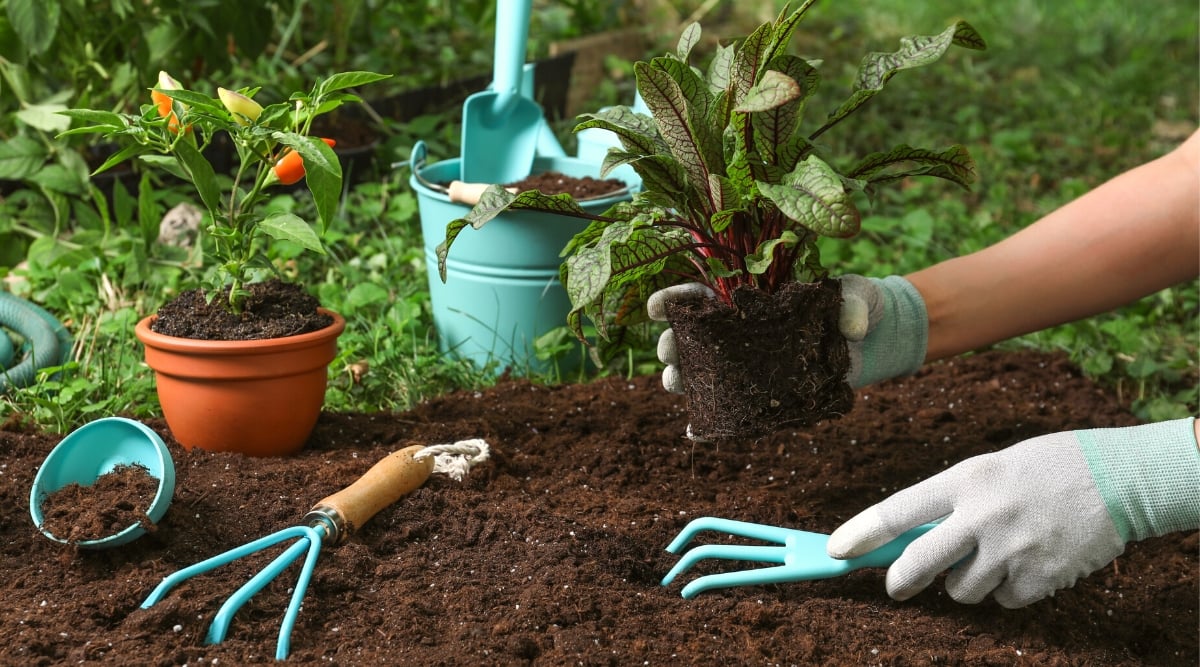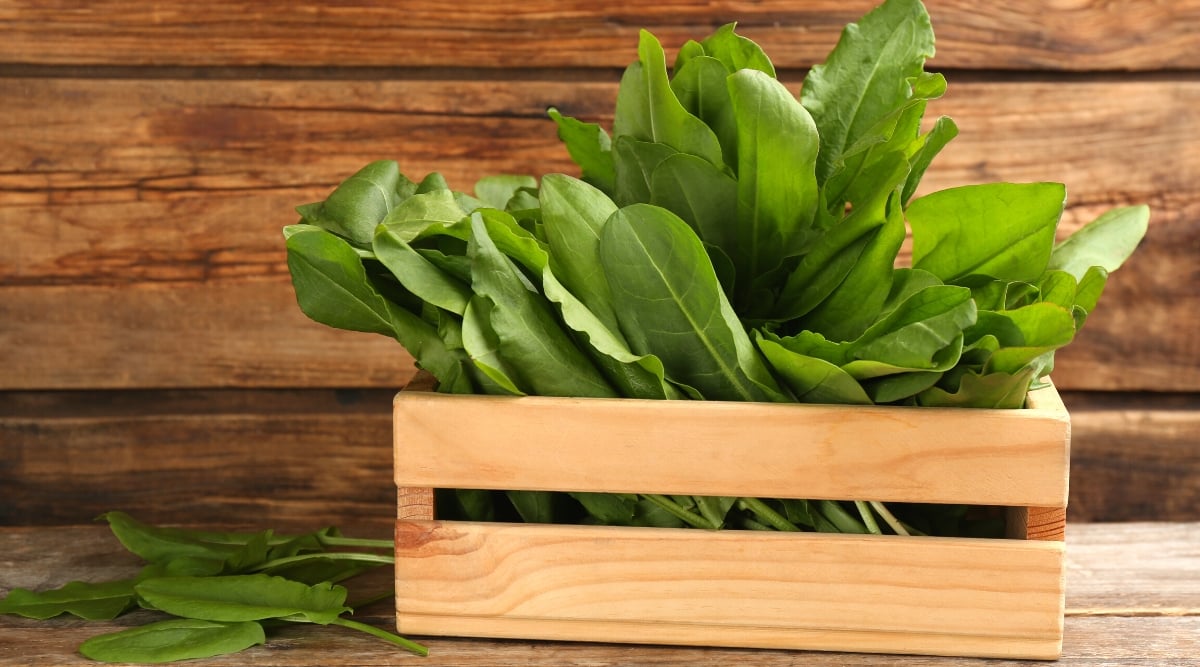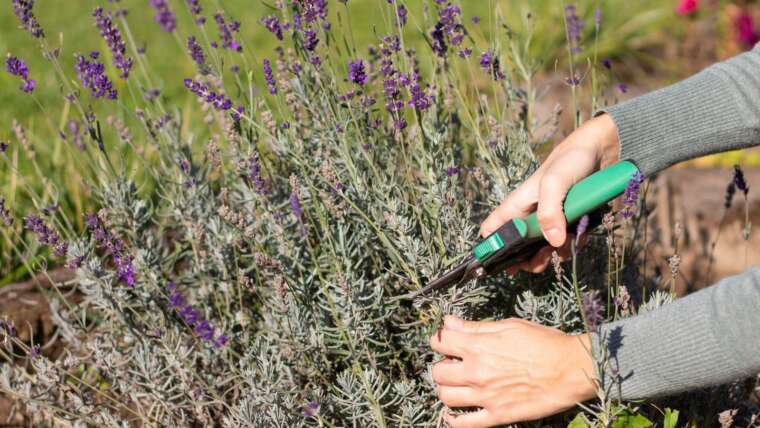If you enjoy a pop of lemony herbs in your salads and dishes, you should consider adding the sorrel plant to your garden! It’s easy to grow and will fit right in with your herb garden or next to your spinach.
Two main types of sorrel are often used in cooking: Rumex acetosa (garden sorrel) and Rumex scutatus (French sorrel). You can use them to make sorrel soup, salad, or cook them up with other greens and veggies. If you’re unfamiliar with it, it cooks up just like spinach, rhubarb, or Swiss chard.
Sorrel can become weedy in the right climate, but it should be easy to control when grown in a backyard garden or a container. You can even grow it indoors all year long. Let’s take a look at how to grow this zesty herb!
Quick Care Guide
| Common Name(s) | Sorrel, garden sorrel, green sorrel, red veined sorrel, narrow-leaved dock, spinach dock, French sorrel |
| Scientific Name | Rumex acetosa, Rumex scutatus |
| Days to Harvest | 35 days for young leaves, 60 days for mature leaves |
| Light | Full sun, partial shade |
| Water | Keep soil moist with at least 1 inch per week |
| Soil | Average, slightly acidic, well-draining |
| Fertilizer | Organic matter or balanced fertilizer |
| Pests | Aphids, butterfly and moth larvae, slugs, snails |
| Diseases | Powdery mildew, root rot |
All About Sorrel Plant
Sorrel is a perennial plant native to Europe and Asia; it grows in moist conditions.
Sorrel—also called dock—is native to most parts of Europe and parts of Asia but can now be found throughout North America and in many gardens. It naturally grows in moist conditions like woodlands or meadows near streams.
When grown in the wild, sorrel is often considered a weed since it can be a bit aggressive. It’s a perennial plant that grows in clumps, and the clumps can get bigger each year.
Rumex acetosa is the most common variety of sorrel used in cooking. It has an acidic flavor reminiscent of lemon zest, so it’ll add a citrusy flavor to your food.
French sorrel (Rumex scutatus) is another common variety and is sometimes preferred because the acidic flavor is tamer than R. acetosa. Young sorrel leaves are preferred to eat because they have the most flavor, while mature leaves are more mellow and aren’t as tender.
Sorrel gets its citrus vibes from oxalic acid, which is actually dangerous to consume in large amounts. However, common sorrel and French sorrel have lower quantities of oxalic acid, so they’re safer to eat.
It’s safe to eat raw, but cooking it will make it even safer. There are some varieties that aren’t used in cooking (R. crispus and R. acetosella) because their levels of oxalic acid are too high to consume safely.
Sorrel plants are native to all of Europe and Asia, and they’re naturalized in many other parts of the world.
Depending on the species, its location, and its associated appearance, common names for sorrel include garden sorrel, green sorrel, red-veined sorrel, narrow-leaved dock, spinach dock, French sorrel, common, or sheep sorrel.
Planting Sorrel
 Sorrel seeds can be planted directly in the ground or started indoors before transplanting.
Sorrel seeds can be planted directly in the ground or started indoors before transplanting.
Sorrel seeds are best planted directly in the ground, but you can start them indoors and transplant them outside if you want to get a head start or if you have a super short growing season.
Whether you start your sorrel seeds indoors or outdoors, choose soil that is rich in organic matter and drains well. Sorrel likes moisture but doesn’t want to stay consistently wet in soggy soil.
Seeds should be planted just under the soil. You can place them on the soil and cover them with a light layer of soil or press them into the soil slightly and barely cover them up. Keep the soil moist but not wet.
If you’re planting sorrel seed indoors, start three weeks before the last frost in the spring. Plant 2-3 seeds in a seed starting pot and thin them out once they have all sprouted so you have just one seedling left.
The seedlings will be a few inches tall by the time you can move them outdoors, and you can start harvesting the tender sorrel leaves almost immediately.
Don’t transplant them outside until the danger of frost has passed, as the seedlings could freeze, and plant the transplants about 6 inches away from each other. If you plant the seeds directly outdoors, sprinkle the seeds in a row and thin them out once they’re a few inches tall.
Caring for Garden Sorrel
Growing sorrel – whether you choose red-veined sorrel, common, or sheep sorrel – is a lot like growing other greens. Keep them watered and keep them cool. Overall, they should be one of the easier plants in your garden!
Sun and Temperature
 Sorrel is best suited for USDA zones 3-7, cool weather, and full sun exposure.
Sorrel is best suited for USDA zones 3-7, cool weather, and full sun exposure.
Sorrel grows best in USDA zones 3-7. They like cool weather and are best suited for spring and fall. When the weather is cool, they like full sun exposure.
But, if you want to grow sorrel through the summer, you’ll need to plant sorrel in a shady area that receives morning sun. Alternatively, try planting sorrel in a container you can move into the shade during the hottest part of the day.
If you live in a colder or hotter climate outside its preferred range, you can grow sorrel leaves indoors all year! Place them under a grow light or by a sunny window, and you’ll have delicious sorrel in no time.
Like other greens, sorrel is sensitive to frost and hot temperatures. Use frost or shade cover when there’s a danger of frost or heat to protect your plants. Sorrel will bolt in hot temperatures, so you may lose your plants as spring transitions to summer in warmer climates.
Water and Humidity
 Keep your soil moist but not wet, and water your plants early in the morning at the base.
Keep your soil moist but not wet, and water your plants early in the morning at the base.
Be sure to give your soil at least one inch of water each week so the top 1-2 inches of soil stays moist. The common and red-veined sorrel plants don’t like to dry out, but they don’t like to be wet, either. Wet soil could lead to root rot and kill your plants.
Water your plants early in the morning at their bases to avoid getting the leaves wet. This will reduce the risk of diseases spreading in your garden and allow the water to soak into the soil before the sun starts to evaporate it.
French sorrel is more tolerant of dry soil, so if consistent water is a common problem in your garden, the French variety should be easier to grow.
Soil
 Plant sorrel in well-draining, slightly acidic soil.
Plant sorrel in well-draining, slightly acidic soil.
Grow sorrel in slightly acidic soil with a pH of 5.5-6.8. If you struggle to keep your soil neutral, pop some sorrel in! As for the type of soil, sorrel isn’t too picky!
Try planting sorrel in soil that drains easily, like a predominately loamy or sandy soil; clay soil is likely to be too heavy unless you mix it with organic matter or perlite.
Fertilization
 Consider using a general vegetable fertilizer high in nitrogen.
Consider using a general vegetable fertilizer high in nitrogen.
If you grow sorrel with plenty of organic matter like compost or leaf mulch, you probably won’t need to apply fertilizer, as the nutrient-rich matter will provide enough.
If you don’t have compost or grow sorrel in poor soil, you can use a general vegetable fertilizer that’s a bit higher in nitrogen since nitrogen helps with leaf production.
Granules will only need to be supplied once or twice in a growing season, while liquid fertilizer will need to be applied more often. Established plants can grow in less-than-ideal conditions in the wild, so you may not even need fertilizer!
Pruning
 Sorrel can be pruned by removing old leaves and flower stalks.
Sorrel can be pruned by removing old leaves and flower stalks.
If you’re growing sorrel for culinary purposes, you probably won’t need to prune your sorrel often since you’ll be eating the leaves! You can prune off older leaves you didn’t harvest in time, and the flower stalks it produces as it tries to bolt.
Pruning as seen in the video above will help promote new growth.
Since sorrel grows in clumps, you can separate the clumps to create new plants. This may be necessary if you grow sorrel as a perennial in your garden and starts to take up too much space.
Propagation
 There are three ways to propagate sorrel: seeds, breaking up clumps, and cuttings.
There are three ways to propagate sorrel: seeds, breaking up clumps, and cuttings.
There are three ways you can propagate sorrel. They all work well, so you can play around and find the method that works for you.
Seeds are probably the easiest way to get sorrel into your garden for the first time. Sorrel grows small pinkish-red flowers once it bolts, which is how it produces seed stalks. You can save the seeds to start new plants next year. Then sow sorrel seeds indoors or outdoors as desired.
For existing plants, you can break up the clumps into smaller clumps and plant them somewhere else to produce a new plant. This method is most effective if you can grow sorrel as a perennial herb. If you have to grow them as annuals in your garden, you won’t get much use out of this method.
Another way to propagate is by cuttings. You can place a leaf in water until it develops roots and then plant it in soil.
Harvesting and Storing Sorrel Plants
Now that you’ve grown sorrel, it’s time to eat it! Let’s look at how you can harvest and store your sorrel fresh or otherwise.
Harvesting Garden Sorrel
 Harvest young and tender sorrel leaves with clean garden shears starting 35 days after planting.
Harvest young and tender sorrel leaves with clean garden shears starting 35 days after planting.
Sorrel is typically best enjoyed when the leaves are young because they’re tender and flavorful. You can start harvesting leaves as soon as 35 days after planting.
Use clean garden shears or scissors to cut leaves at the plant’s base. Start with the outer leaves since those are the oldest. Sorrel is a cut-and-come-again green, so it will continue to produce new growth, so you can harvest from it again and again!
If you don’t mind the taste of older fiddle-shaped leaves, you can wait until the plant has grown a bit for a bigger harvest to eat all at once. If you prefer the younger leaves, sow sorrel seeds in succession so you’ll always have some on hand.
Storing Sorrel Leaves
 To store sorrel, keep harvested leaves in a plastic bag in the fridge for a week.
To store sorrel, keep harvested leaves in a plastic bag in the fridge for a week.
Store harvested sorrel leaves in a plastic bag in the fridge with a paper towel to absorb excess moisture. Leaves will be fresh for up to one week. Don’t wash your sorrel until you’re ready to use it to prevent excess moisture in the bag.
For long-term storage, wash the sorrel and allow it to dry out completely. Then, chop it up and store it in a freezer bag. It can stay in your freezer for several months.
Another long-term solution is an “herb cube.” Fill an ice cube tray with chopped sorrel and olive oil and put it in the freezer. Next time you need to cook with oil and sorrel, pop it in the pan, and you’re ready to go! You can add other perennial herbs to pack in more flavor too.
Troubleshooting
Sorrel isn’t really a troublemaker since it’s disease-resistant and has very few pest problems. But here are a few things to look out for.
Growing Problems
 Sorrel prefers cool weather and may start bolting in hot climates.
Sorrel prefers cool weather and may start bolting in hot climates.
Sorrel is a hardy perennial, but it can be tough to grow in hot climates since it likes cool weather. While it’s happy to grow in zones 3-7, it may start bolting in late spring or early summer in areas that warm up pretty quickly.
You can slow down the bolting process by planting it in an area that receives afternoon shade or indoors. In zones above 7, you’ll have to plant it indoors or in shady areas.
Pests
 To get rid of aphids, use a strong jet of water or neem oil.
To get rid of aphids, use a strong jet of water or neem oil.
The pests that might bother sorrel are likely going to be found throughout your garden since there aren’t really any sorrel-specific pests.
Aphids come in many colors and suck the sap from leaves and stems. The easiest way to get rid of them is to wash them off with water. Neem oil is also helpful for suffocating them.
Snails and slugs are often attracted to greens of all kinds. Diatomaceous earth can help kill snails and slugs, but DE is really only effective when it’s dry, and sorrel likes moist soil, so it may not be that effective. Pick them by hand. You can wear gloves if you think that’s an icky task!
Beneficial nematodes are another great natural way to kill slugs, as these nematodes look for critters and not plants. There are many slug and snail killers on the market, so look for an option that will suit your garden.
Diseases
 Sorrel is disease-resistant but may get powdery mildew and root rot from overwatering.
Sorrel is disease-resistant but may get powdery mildew and root rot from overwatering.
There aren’t any diseases that are specific to sorrel, making it a friend to many gardens! Even so, it may succumb to powdery mildew if other plants in your garden have the disease. You can prevent it with a fungicide, but you’ll have to throw away infected plants since there isn’t a cure.
If your soil is too wet, your sorrel may develop root rot, which will eventually kill the whole plant. Don’t water by hand if it rained recently, and try not to give your plant more than one inch per week.
Frequently Asked Questions
Q: Can you eat sorrel plant?
A: Sorrel is delicious and nutritious and is great in soups, salads, casseroles, and any other dishes that might need some lemony flavor.
Q: Is sorrel toxic to humans?
A: Sorrel has oxalic acid, which is toxic to humans in large amounts. Adding sorrel to salad won’t be enough to hurt you, so it’s safe to eat.
Q: Where does sorrel grow best?
A: Sorrel grows best in a sunny location with moist soil in spring or fall.
Q: Does sorrel come back every year?
A: Sorrel can usually be grown as a perennial in USDA zones 5-7, meaning it will come back every year.
Q: Is sorrel safe to eat raw?
A: Sorrel is safe to eat raw in small amounts. (Maybe don’t eat pounds of it every day!)
Q: What does sorrel taste like?
A: Sorrel tastes a lot like lemon zest – it’s tangy and citrusy.
Q: What types of sorrel are edible?
A: Rumex acetosa (common sorrel) and Rumex scutatus (French sorrel) are the safest varieties to eat because of their lower levels of oxalic acid.
Q: Is sorrel hard to grow?
A: Sorrel is usually easy to grow if the soil is moist, the temperatures aren’t too hot, and it gets enough sunlight.




